When I think about the coyote vs dog comparison, it’s fascinating to explore how different these two creatures really are. Coyotes stand around 18–23 inches tall at the shoulder and weigh between 25 to 40 pounds. Meanwhile, dogs come in all shapes and sizes, with some breeds like Great Danes reaching up to 150 pounds.
Despite their differences, both animals share common traits from the Canidae family. Coyotes usually have longer muzzles and smaller ears, giving them a distinctive look. These physical differences play a big role in their behaviours, whether they’re in the wild or living alongside humans.
Can a coyote be domesticated like a dog?
Coyotes cannot be domesticated like dogs. While both belong to the Canidae family, coyotes are wild animals with instincts and behaviours that differ significantly from domesticated dogs. Unlike dogs, which have been selectively bred for thousands of years to live with humans, coyotes remain solitary, independent, and territorial.
Their wild nature makes them difficult to train and prone to aggression, especially around humans. Though some people may try to raise coyotes, they typically do not adapt well to domestic life and can pose risks to both humans and pets due to their unpredictable behaviour.
Read more: Learn how Anatolian Shepherds differ from Kangal dogs in our detailed guide: Anatolian Shepherd vs Kangal Dog.
Comparison Table
Coyote vs Dog Differences
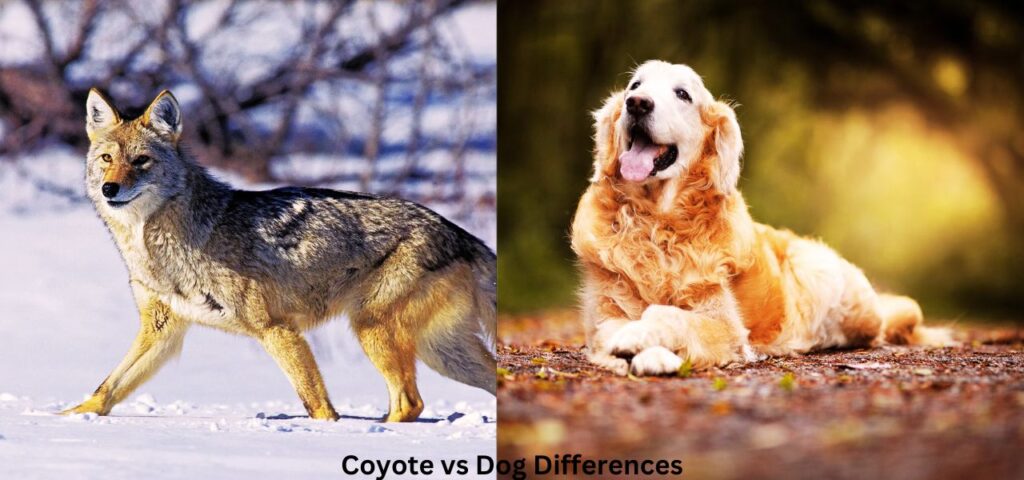
Physical Characteristics
Let’s dive into the physical differences between coyotes and dogs. These traits are fascinating because they reveal a lot about how each species has adapted to its environment.
Size and Weight
Coyotes are usually between 18–23 inches tall at the shoulder and weigh around 25–40 pounds. On the other hand, dogs come in a much wider range of sizes, with breeds like the Chihuahua weighing just 2 pounds, and giant breeds like the Saint Bernard can reach 180 pounds. When considering Coyote vs Dog, the coyote is typically smaller and leaner, but some larger dog breeds can outsize them.
Appearance
Fellows, coyotes have a slender build with a narrow muzzle and pointy ears. Their coat is typically gray, brown, or reddish-brown, and their tail is long and bushy. Dogs, however, come in a variety of shapes, colors, and sizes, from short-haired Dachshunds to thick-coated Huskies.
Distinctive Features
One of the clearest differences is that coyotes often have longer muzzles and smaller, pointier ears. Dogs, depending on the breed, may have a broader face and bigger ears, especially in breeds like the German Shepherd. The difference in their faces makes them easy to tell apart!
Behavior and Temperament
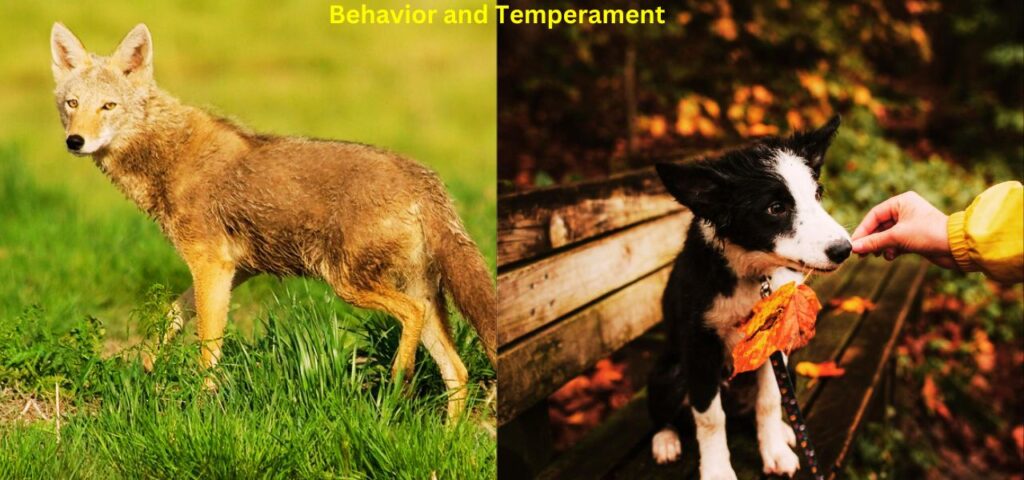
In this section, we’ll look at the behavior and temperament of coyotes and dogs, two animals that, despite being related, act very differently. Whether in the wild or as pets, their behaviors are shaped by their needs and environment.
Social Structure
Friends, coyotes tend to be more solitary than dogs. While they can form family units, coyotes often hunt and roam alone. In a coyote vs dog comparison, dogs, especially domesticated ones, are naturally social creatures. They thrive in packs or as part of a family, with many breeds specifically bred for companionship.
Communication
That’s because coyotes communicate using a wide variety of vocalizations, including yips, howls, and barks. They have a vocal range that can be heard over long distances. Dogs, however, use barks, whines, and growls to express themselves, and these sounds are typically directed toward humans or other animals. Both animals are highly vocal, but their communication is context-driven.
Diet and Feeding Habits
Never missing an opportunity, coyotes are opportunistic eaters. They mainly hunt small mammals, birds, and insects but will scavenge when necessary, sometimes eating fruits or garbage. Dogs, in contrast, are omnivores, relying heavily on human-provided food. They can eat a variety of foods, from meat to vegetables, though their diet is usually carefully managed to ensure they get the right nutrients.
Read more: Follow our step-by-step advice on Dog Broken Nail Home Treatment to care for your pet’s injury.
Habitat and Distribution

In this section, we will explore where coyotes and dogs live and how their habitats differ. It’s fascinating to see how adaptable coyotes are compared to our domesticated dogs.
Geographical Range
Coyotes are native to North and Central America, with populations in the U.S., Mexico, and Canada. They’ve expanded their range significantly, even adapting to urban environments. In fact, coyotes now inhabit more areas than ever, from rural regions to city outskirts. When considering coyote vs dog, it’s important to note the differences in behavior, size, and adaptability, with coyotes often being more elusive and wild compared to domesticated dogs.
Habitat Preferences
Yes, coyotes are extremely versatile when it comes to habitat, living in woodlands, deserts, grasslands, and even cities. Their adaptability is remarkable urban coyotes have been found thriving in places like Los Angeles. Dogs, on the other hand, live primarily in human-controlled spaces, from suburban backyards to apartments.
Distribution of Dogs
Dogs are domesticated and live almost everywhere in the world. From small apartments in Tokyo to farms in the countryside, dogs are found in human-designed environments. Interestingly, over 60 million dogs are estimated to live in the U.S. alone, showing their widespread presence.
How Habitat Affects Behavior
The environment where a coyote lives significantly influences its behavior. Coyotes in urban areas may adapt to human presence, becoming nocturnal to avoid interactions. Meanwhile, domesticated dogs’ behavior is shaped by their human owners, often focused on companionship and safety. Choose the right Antifungal Shampoo for Dogs to ensure your dog’s skin stays healthy and itch-free.
Lifespan and Health
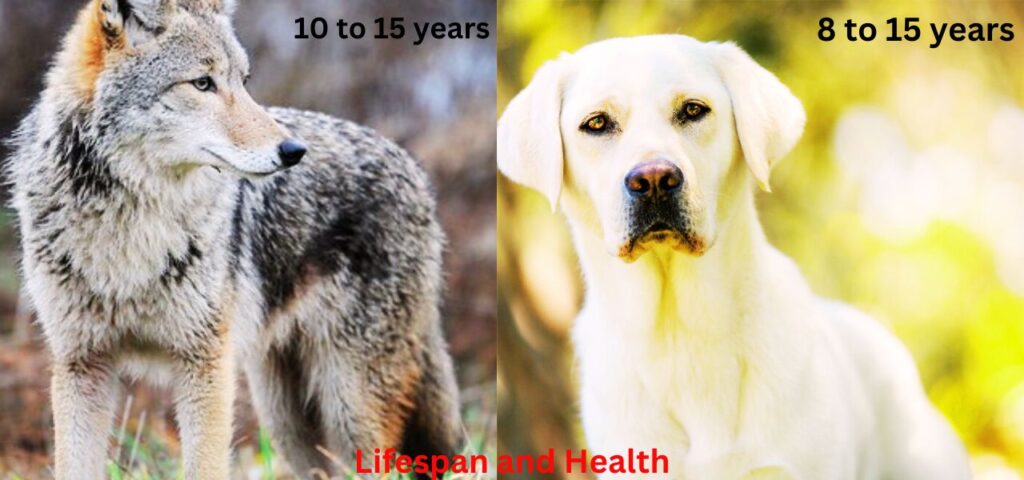
When comparing coyotes and dogs, their lifespan and health conditions reveal interesting differences. Let’s break down how long each typically lives and the health concerns they face.
Lifespan of Coyotes
Coyotes generally live between 10 to 15 years in the wild. However, their lifespan can be cut short by predation, disease, or accidents. In captivity, some coyotes may live longer with proper care and a controlled environment.
Lifespan of Dogs
For dogs, the lifespan varies greatly depending on the breed. On average, dogs live 8 to 15 years, but smaller breeds tend to live longer than larger ones. For example, Chihuahuas can live up to 20 years, while larger dogs like Great Danes may only reach 7 to 10 years.
Health Concerns in Coyotes
Coyotes face health challenges from diseases like rabies and canine distemper, which can be fatal if not treated. They are also at risk from parasites such as ticks and heartworms. These factors contribute to their relatively short lifespan in the wild.
Health Concerns in Dogs
Dogs are prone to breed-specific health issues, with conditions like hip dysplasia, heart disease, and cancers being common. Larger breeds are more susceptible to joint problems, while smaller breeds often suffer from dental issues. Regular vet checkups can help mitigate these risks.
Interactions with Humans
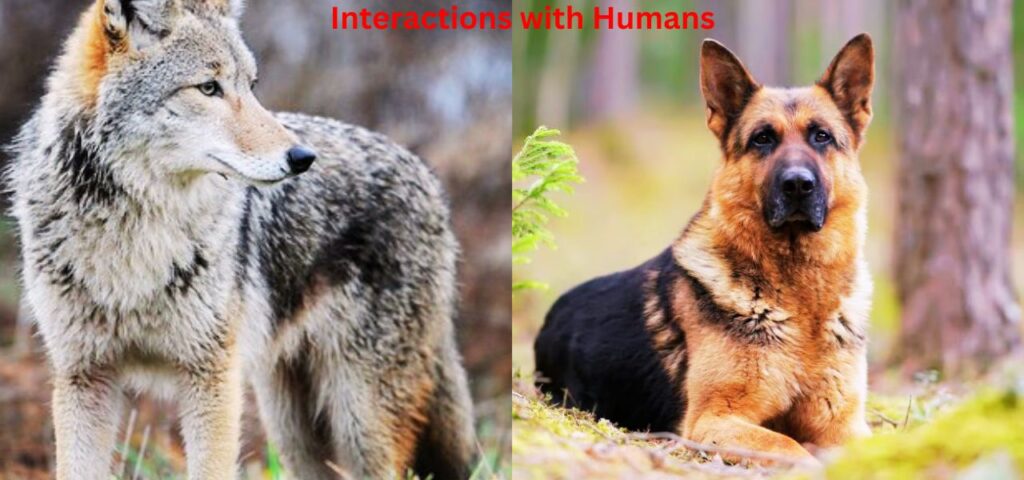
When it comes to coyotes and dogs, their interactions with humans differ greatly. While dogs are often cherished as pets, coyotes remain wild animals that typically avoid human contact. Let’s explore how each one relates to humans.
Domestication: Dogs vs. Coyotes
Dogs have been domesticated for thousands of years. In fact, their domestication dates back around 15,000 to 40,000 years, depending on the region. Coyotes, on the other hand, have never been domesticated and continue to live in the wild, maintaining their independence.
Coyotes and Humans: A Complicated Relationship
These are often seen as a nuisance in urban areas. There have been reports of coyote attacks on small pets, with some studies showing that over 3,000 incidents occur annually in the U.S. Their presence in cities can create fear, but it’s important to note that most coyotes prefer to stay out of sight.
Dogs and Wildlife: Maintaining Balance
Dogs, when let off-leash, can sometimes pose a threat to wildlife. Studies show that 20% of domestic dogs may chase smaller animals when given the opportunity. This is why it’s essential for dog owners to maintain control and prevent any unintended harm to local wildlife.
Read more: Discover the distinctions between Alsatian and German Shepherd breeds in our article: Alsatian Dog vs German Shepherd.
Legal and Ethical Considerations
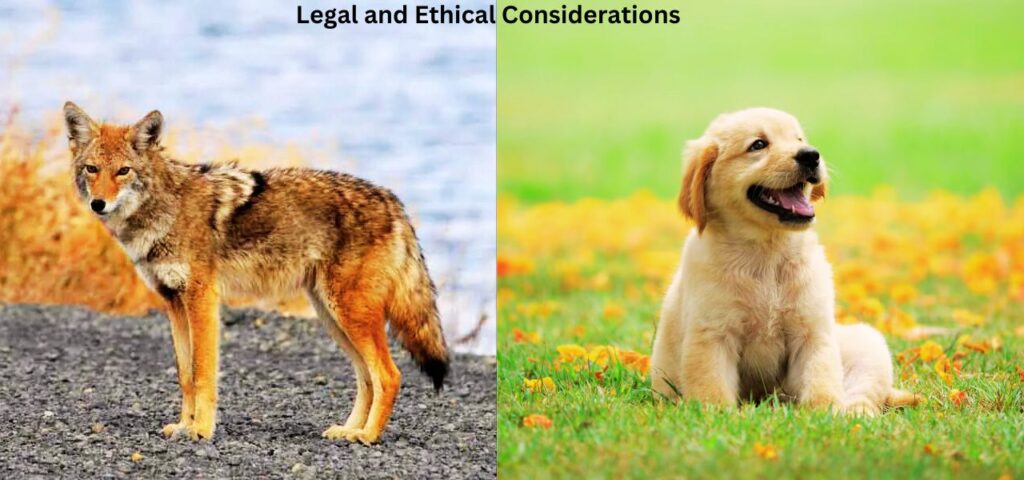
In this section, we’ll dive into the legal and ethical aspects of coyotes and dogs. From conservation efforts to human-wildlife conflicts, understanding these issues is crucial.
Coyotes and Conservation Status
Coyotes are generally not considered endangered. In fact, their population is booming, with an estimated 3 to 5 million in North America. Their adaptability has led them to thrive in urban and rural environments alike.
Dogs and Ethical Considerations
Dogs, as domesticated animals, require us to ensure their well-being. Ethical dog breeding is vital, with 70-80 million pet dogs in the U.S. alone. We must also emphasize responsible ownership to avoid overpopulation and neglect.
Human-Wildlife Conflict
When it comes to human-wildlife interactions, coyotes are often seen as a problem in urban settings. In places like California, over 20% of wildlife calls involve coyotes. Addressing this requires education and management strategies like habitat modification and public awareness.
Dogs and Wildlife Interactions
On the other hand, dogs can pose risks to wildlife. It’s reported that in some areas, up to 40% of domestic dogs are involved in encounters with wild animals. Leash laws and secure fencing are essential in preventing such conflicts. Find out if You Can Use Baby Shampoo on Dogs and its effects on their coat and skin.
Wrap Up
After researching the “coyote vs dog” comparison, it’s clear how these two animals differ in many ways. Coyotes, with an average weight of 25–40 pounds, are more slender than most domestic dogs, which can weigh up to 150 pounds.
Despite their differences, both animals share the same family and display incredible adaptability. Understanding the behaviours and habitats of these animals helps us appreciate their roles in nature, ensuring that we coexist peacefully with wildlife while keeping our pets safe.




